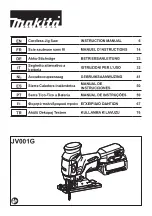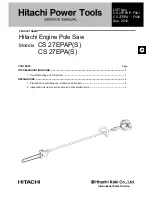
4
TKN 80D • TKN 95D
EN
risk of electric shock.
d) Do not abuse the cord. Never use the cord for
carrying, pulling or unplugging the power tool.
Keep cord away from heat, oil, sharp edges or
moving parts.
Damaged or entangled cords in-
crease the risk of electric shock.
e) When operating a power tool outdoors, use an
extension cord suitable for outdoor use.
Use of
a cord suitable for outdoor use reduces the risk of
electric shock.
f) If operating a power tool in a damp location
is unavoidable, use a residual current device
(RCD) protected supply.
Use of an RCD reduces
the risk of electric shock.
3. PERSONAL SAFETY
a) Stay alert, watch what you are doing and use
common sense when operating a power tool.
Do not use a power tool while you are tired or
under the influence of drugs, alcohol or medi-
cation.
A moment of inattention while operating
power tools may result in serious personal injury.
b) Use personal protective equipment. Always
wear eye protection.
Protective equipment such
as dust mask, non-skid safety shoes, hard hat, or
hearing protection used for appropriate conditions
will reduce personal injuries.
c) Prevent unintentional starting. Ensure the
switch is in the off-position before connecting
to power source and/or battery pack, picking
up or carrying the tool.
Carrying power tools with
your finger on the switch or energising power tools
that have the switch on invites accidents.
d) Remove any adjusting key or wrench before
turning the power tool on.
A wrench or a key left
attached to a rotating part of the power tool may
result in personal injury.
e) Do not overreach. Keep proper footing and bal-
ance at all times.
This enables better control of
the power tool in unexpected situations.
f) Dress properly. Do not wear loose clothing or
jewellery. Keep your hair, clothing and gloves
away from moving parts.
Loose clothes, jewel-
lery or long hair can be caught in moving parts.
g) If devices are provided for the connection of
dust extraction and collection facilities, en-
sure these are connected and properly used.
Use of dust collection can reduce dust-related haz-
ards.
4. POWER TOOL USE AND CARE
a) Do not force the power tool. Use the correct
power tool for your application.
The correct
power tool will do the job better and safer at the
rate for which it was designed.
b) Do not use the power tool if the switch does
not turn it on and off.
Any power tool that can-
not be controlled with the switch is dangerous and
must be repaired.
c) Disconnect the plug from the power source
and/or the battery pack from the power tool
before making any adjustments, changing ac-
cessories, or storing power tools.
Such preven-
tive safety measures reduce the risk of starting the
power tool accidentally.
d) Store idle power tools out of the reach of chil-
dren and do not allow persons unfamiliar with
the power tool or these instructions to operate
the power tool.
Power tools are dangerous in the
hands of untrained users.
e) Maintain power tools. Check for misalignment
or binding of moving parts, breakage of parts
and any other condition that may affect the
power tool’s operation. If damaged, have the
power tool repaired before use.
Many accidents
are caused by poorly maintained power tools.
f) Keep cutting tools sharp and clean.
Properly
maintained cutting tools with sharp cutting edges
are less likely to bind and are easier to control.
g) Use the power tool, accessories and tool bits
etc. in accordance with these instructions, tak-
ing into account the working conditions and
the work to be performed.
Use of the power tool
for operations different from those intended could
result in a hazardous situation.
5. SERVICE
a) Have your power tool serviced by a qualified
repair person using only identical replacement
parts.
This will ensure that the safety of the power
tool is maintained.
IV - Additional safety rules
for mitre saws
WARNING:
Before connecting a tool to a power
source be sure that the voltage supply is the same as that
specified on the nameplate of the tool.
A power source with a voltage greater than that specified
for the tool can result in serious injury to the user, as well
as damage to the tool.
If in doubt, do not plug in the tool.
Using a power source with a voltage less than the name-
plate rating is harmful to the motor.
▪
Always remove the plug from the mains socket
before making any adjustments or maintenance,
including changing the blade.
▪
Never use a cracked or distorted saw blade.
▪
If the table insert is damaged or worn, have it replaced
by an authorised service centre.
▪
Use only blades as recommended by the manufac-
turer and which conform to EN 847-1.
▪
Do not use blades of High Speed Steel (HSS blades).
▪
Select saw blades in relation to the material being cut.
▪
Wherever possible use blades that are designed to
reduce emitted noise.
▪
Note the direction of rotation of the motor and the
blade.
▪
When operating the saw, use safety equipment in-
cluding safety goggles or shield, ear defenders, dust
mask and protective clothing including safety gloves.
pages-TKN-80-95D-2012.indd 4
4.7.2012 г. 11:15:14 ч.







































